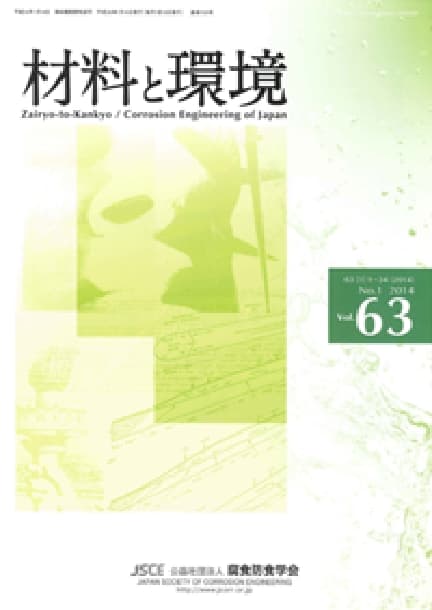- TOP
- Zairyo-to-Kankyo
- Vol. 73 (2024), No. 2
Zairyo-to-Kankyo Vol. 73 (2024), No. 2
Backnumber
-
Vol. 74 (2025)
-
Vol. 73 (2024)
-
Vol. 72 (2023)
-
Vol. 71 (2022)
-
Vol. 70 (2021)
-
Vol. 69 (2020)
-
Vol. 68 (2019)
-
Vol. 67 (2018)
-
Vol. 66 (2017)
-
Vol. 65 (2016)
-
Vol. 64 (2015)
-
Vol. 63 (2014)
-
Vol. 62 (2013)
-
Vol. 61 (2012)
-
Vol. 60 (2011)
-
Vol. 59 (2010)
-
Vol. 58 (2009)
-
Vol. 57 (2008)
-
Vol. 56 (2007)
-
Vol. 55 (2006)
-
Vol. 54 (2005)
-
Vol. 53 (2004)
-
Vol. 52 (2003)
-
Vol. 51 (2002)
-
Vol. 50 (2001)
-
Vol. 49 (2000)
-
Vol. 48 (1999)
-
Vol. 47 (1998)
-
Vol. 46 (1997)
-
Vol. 45 (1996)
-
Vol. 44 (1995)
-
Vol. 43 (1994)
-
Vol. 42 (1993)
-
Vol. 41 (1992)
-
Vol. 40 (1991)
Keyword Ranking
18 Dec. (Last 30 Days)
Zairyo-to-Kankyo Vol. 73 (2024), No. 2
Present Status of Additive Manufacturing for Metallic Components and Key Point from the Viewpoint of Corrosion Resistance
Shuji Hashizume
pp. 26-31
DOI:
10.3323/jcorr.73.26Abstract
Recently, careful attention has been paid to additive manufacturing for metallic components. Additive manufacturing will be effective when a small amount of metallic components are necessary in short time. Additive manufacturing equipment for metallic components showed higher cost than that for plastic components. Therefore, cheaper methods have been recently developed. This report will focus to metallic components. Activity for utilize additive manufacturing in oil and gas industry and examination of corrosion performance are reported. Key points of producing superior corrosion resistant alloys metallic components by additive manufacturing will be discussed.
Readers Who Read This Article Also Read
ISIJ International Vol.64(2024), No.2
Assessment of Corrosion near Exposed Rebars in Reinforced Concrete Manhole
Yosuke Takeuchi, Ryou Makino, Junichirou Tamamatsu
pp. 32-36
DOI:
10.3323/jcorr.73.32Abstract
Reinforced concrete structures are generally repaired when cracks or exposed rebar are detected. However, considering the shortage of maintenance personnel for infrastructure facilities, it becomes necessary to continue monitoring even after rebar exposure and predict the optimal timing for repairs. Therefore, in this study, accelerated tests using simulated rebar exposure specimens and field investigations of actual structures were conducted to evaluate the progress of corrosion after rebar exposure. As a result, it was found that localized deterioration preceded the corrosion in the exposed rebar and that the expansion of the corrosion area was limited.
Article Access Ranking
18 Dec. (Last 30 Days)
-
Delayed Fracture Mechanism of 1700 MPa-Class Quenched and Tempered Bolt under Atmospheric Corrosion Environment
Tetsu-to-Hagané Advance Publication
-
Perspectives on the Promising Pathways to Zero Carbon Emissions in the Steel Industry toward 2050
ISIJ International Vol.65(2025), No.2
-
Effect of B on Surface Oxidation Behavior and Phosphatability of Si-Mn-added Cold-Rolled Steel Sheets
ISIJ International Advance Publication
-
Factors Influencing the Bonding Phase Structure of Iron Ore Sinters
ISIJ International Vol.43(2003), No.9
-
Effect of microstructural heterogeneity on fatigue limit of as-quenched low-carbon low-alloy martensitic steel
ISIJ International Advance Publication
-
Prussian blue as a fully reversible hydrogenochromic material for visualizing hydrogen distribution in Fe sheet
ISIJ International Advance Publication
-
Metallurgical Aspects on Interstitial Free Sheet Steel From Industrial Viewpoints
ISIJ International Vol.34(1994), No.1
-
Microstructures and Reduction Properties of High CaO Concentration Sintered Ore
ISIJ International Advance Publication
-
Influence of Antimony on the Oxidation Characteristics of 65Mn Steel
ISIJ International Advance Publication
-
From plasticity to fracture in pearlitic microstructures: Atomistic study of cementite thickness and deformation localization
ISIJ International Advance Publication
You can use this feature after you logged into the site.
Please click the button below.










